#vegetable pulao recipe
Link
1 note
·
View note
Photo
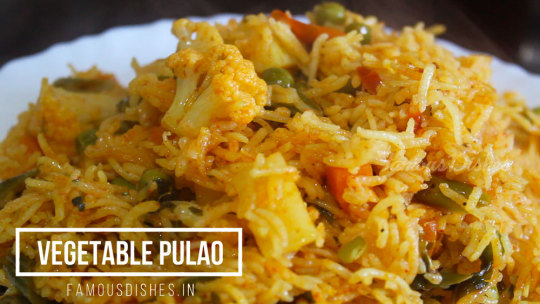
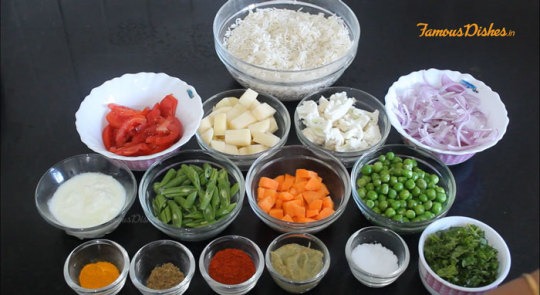


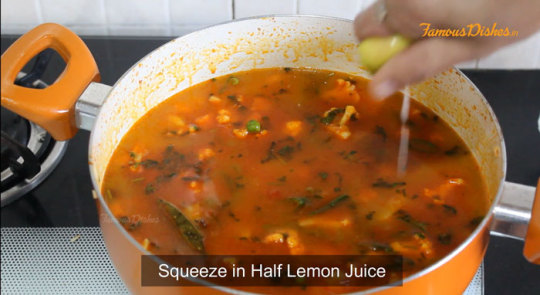

A #delicious Veg Masala Pulao #dish made from basmati rice, vegetables, spices and herbs. It’s easy to cook and takes less than 30 minutes to prepare.
Checkout Our Detail Recipe ➡️ https://famousdishes.in/recipe-veg-pulao-how-make-vegetable-pulao/
Checkout recipe video ➡️ https://youtu.be/hCUnmvSkUjY
#VegMasalaPulao
#VegetablePulaoRecipe
#PulaoRecipe
0 notes
Text
గోబీ ఫ్రైడ్ రైస్
4 notes
·
View notes
Text
Vegetable Pulao Recipe | How to make veg Pulao
Vegetable Pulao Recipe
Vegetable pulao, also known as veg pulao, is a popular Indian rice dish made with rice and a mix of assorted vegetables. If you are looking for simple, one-pot comfort food that’s easy to make and tasty, then You can also make this.
This is loaded with lots of vegetables, and the best part is you can add any vegetables you want to make this Pulao.
This Vegetable Pulao…
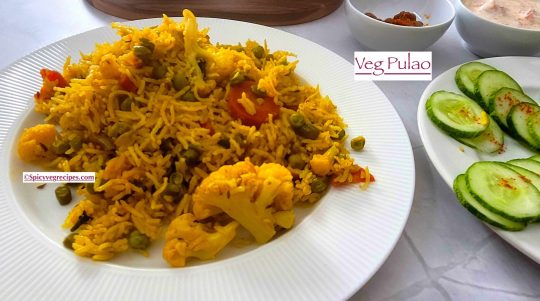
View On WordPress
#best veg pulao recipe#easy#Easy Recipes#Easy Veg Pulav Recipe#How to cook#how to make pulao#how to make pulao in Pressure Cooker#how to make veg Biryani#how to make veg pulao#How to make vegetable Biryani#How to make Vegetable Pulao#Indian recipe#matar pulav#mixed vegetable Pulao#pilau#pilau recipe#Pressure Cooker Pulao#pressure cooker pulao recipe#pulao#pulao in pressure cooker#pulao recipe#Pulao Recipe in Hindi#pulav recipe#Quick Recipes#Regional Indian Cuisine#restaurant style veg pulao#Simple Veg Pulao Recipe#Simple vegetable pulao#step by step#veg Biryani recipe
0 notes
Text
Vege Pulao Restaurant Style | Simple Veg Pulao Recipe | Veg Pulao Recipe Sanjeev Kapoor
So today we have brought for you the recipe of simple and tasty Veg Pulao and also read what are the things needed to make Veg Pulao.
So let's Start the Recipe of Veg Pulao
How To Make Delicious Veg Pulao at Home : Veg Pulao Recipe in English Step by Step
Step.1 First of all put oil in a pan and heat the oil then after the oil is heated add 1 black cardamom and 7 or 8 black peppercorns and a little cumin and chopped 3 or 4 green chilies and onions and add onions to the pan. Cook the onions in the pan till light brown Read More

1 note
·
View note
Note
Hey Najia! I love this blog so much! I have a question. I find cooking pretty difficult sometimes. I'm chronically ill and also the kitchen stresses me out a bit because I'm very scatterbrained and there's knives and fire and stuff. I also fuck things up in the kitchen pretty easy. Are there any recipes on here you find particularly easy to make? That you'd recommend for when you just cannot be arsed? Hope you're having a wonderful day, I know it's your birthday 😄🎉
Thank you!
I can understand your stress—cooking can involve things that are objectively dangerous and also time-sensitive. I'd recommend:
Try recipes where you don't have to come into direct contact with the blades you use. Some Indian dals, for example, cook lentils in a sauce made from blended onion, tomato, and garlic; you could process them using a food processor or blender. A lot of things (fresh salsa, guacamole, a duqqa of garlic, chilies, and spices that you can throw in to cook with some lentils) can be prepared in a mortar and pestle, too.
I've never used one, but a vegetable chopper might help in a similar way that a food processor would, by reducing the amount of knifework that you have to do. There are a lot of recipes where a chopped onion is the only knifework required.
Also try recipes that are cooked in the oven, and not on the stovetop. Something that gets thrown into the oven on low heat to cook (like a casserole or fukharat dish) takes longer, but is more hands-off, than something that's cooked on the stove.
Do all of your prep work first. Read through the recipe and see what chopping, blending &c. needs to be done, prep each ingredient, and put it in its own little bowl. This includes anything in the ingredients list that says "1 onion, diced" or similar: do that right off the bat. If the recipe says "meanwhile" or asks you to do prep for anything while anything else is cooking, you might choose to disregard that and do all the prep first, depending on how long the cook time is and how much attention it needs (e.g., soup on a low simmer for half an hour can pretty much be left alone; anything in a frying pan cannot). This way you won't be rushing to chop anything quickly while worrying that something else is going to overcook.
Look for vegetables, like broccoli / cauliflower / romanesco and green beans, that can be broken up with your hands rather than chopped. Rip up cilantro and parsley rather than chopping them.
Admittedly "simple" is not the guiding principle of this blog, but here are some recipes that I think could be easily adapted:
Fukharat l3des: just one onion to chop. Cooked on low heat in the oven.
Fried tofu sandwich: just mixing sauces and spices. You can skip coating the tofu in cornstarch and frying it. Instead try freezing the whole block, thawing it, cutting into two or four pieces, and then marinating it in a plastic bag with your sauce overnight. Then bake the tofu for 15-20 minutes, turning once, at 350 °F (180 °C).
Roasted celery and potato soup: requires only very rough chopping; the cooking methods are baking and simmering. The fried tempering could be skipped by just adding those ingredients into the simmer earlier.
Carrot salad or chickpea salad or tapenade: you could throw all of the ingredients in a food processor.
Moroccan lentils: just an onion and tomato to grate or process.
Kashmiri lal chaman: the only thing you need to cut is tofu; the gravy is just water and spices. You could bake the tofu instead of frying it.
Black bean burgers: no chopping or frying if you omit the onion and carrot and elect to bake the finished patties.
'Chicken' and olive tajine: the marinade is blended or pounded, and there is no other prepwork to do other than chopping one onion. Everything can be simmered on low heat until cooked, so it's pretty hands-off.
Chana pulao: mostly rice, chickpeas, and spices. Some aromatic prep, but you could crush instead of chopping those.
Romanesco quiche: no knifework at all if you omit the aromatics and break aprt the romanesco with your hands.
Spanish garlic mushrooms: just crush garlic instead of slicing and buy pre-sliced mushrooms. There is frying, though.
Eggplant cooked salad: the eggplant is broiled and then spooned out. No knifework required if you use tomato puree.
Butternut squash soup: just roasting and simmering. No knifework required if you omit the aromatics and buy pre-cubed squash.
Dishes with a base of lentils, chickpeas, beans, rice, and/or noodles are great because there's no knifework that needs to be done to prepare the beans &c. themselves.
161 notes
·
View notes
Text
Plov is a rice pilaf-style dish that became popular in the Soviet Union by way of Uzbekistan. Plov’s popularity in Russia can be traced back to at least the time of Alexander the Great. Upon returning from Central Asia to Macedonia, his soldiers were said to have brought back plov as one of their new favorite foods. The existence of this dish in Central Asia has a distinct tie to the Jewish community there. The Bukharian Jews of Central Asia are Mizrahi Jews whose lineage goes back to the time of King David and ancient Persia. During the reign of Persia’s Cyrus the Great, Jews made their way to Central Asia and formed a community where they eventually spoke a dialect of Persian called Bukhori. Central Asian versions of plov, particularly the Uzbeki variety, were later popularized across all Soviet republics during the time of the Soviet Union.
Plov can be similar to Indian pulao or Spanish paella, though ultimately, there are countless cultures that have some version of a one-pot rice and meat dish.
Soviet-style plov is most commonly made with lamb as its meat, carrots as its vegetable, and is typically spiced with cumin and coriander. However, you will find a wide range of plov made with different kinds of meat or poultry, spices, and even the addition of dried fruits or nuts.
I prefer to keep plov simple with traditional flavors. I use chicken thighs for their availability and affordability, and add loads of carrots and onions, which seem to magically disappear into the rice once cooked. Garlic, bay, cumin and coriander perfume this plov. This dish is a one-pot meal. Once all of the ingredients are prepped, it comes together quickly and then gets popped into the oven to finish cooking. It reheats and freezes well, and is hearty and filling.
12 notes
·
View notes
Text
Currently throwing together my own mashup of these two recipes:
(Where the second method sounds more like a fish biryiani to me, but hey. I am also sitting in Scandinavia.)
I liked the idea of baking everything like a simple chicken and rice fish, but also liked the idea of more spices today.
We had a 500g bag of frozen Pangassius catfish filets that I wanted to eat, and I didn't feel like frying them. I was also in the mood for rice. Figured something like this should cover multiple bases. It even gave me a good opportunity to repurpose some leftover just spiced raita (no vegetable bits or anything) for the fish marinade.
Seasoned rice and peas are currently prebaking before the fish goes on top. Guess we'll see how this little experiment turns out. Tempted to try taking some baked chicken and rice in a more South Asian pulao direction too at some point, now that I am reminded.
5 notes
·
View notes
Text
INDIAN FOODS IN USA
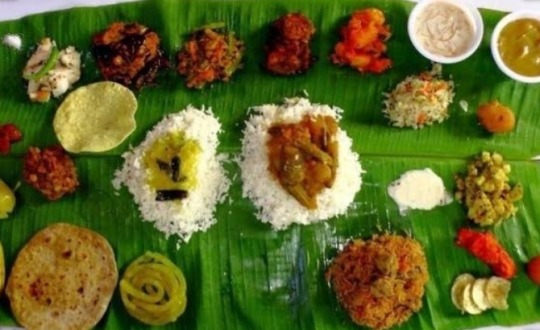
Hi Readers, welcome to indianfoodinusadotcom, Here you can learn all about Indian foods, recipes and all about INDIAN FOOD like {ABOUT INDIAN FOOD}
{HISTORY}
{VEDIC AGES}
{ANTIQUITY}
{FOOD MENTIONED IN ANECIENT INDIAN SCRIPTURE}
{MIDDLE AGE OF 16th CENTURY}
{COLONIAL PERIODS}
{INGREDIENTS}
{RECIPES}
LIKE (a) chicken Biryani (b) mutton biryani (c)Butter chicken (d) chicken tikka masala (e) veg biryani (f) Palak paneer (g) Matar paneer (h) chutneys, AND Many more.
ABOUT INDIAN FOOD in USA
You will get know more about the best restaurants Around the world
INDIAN FOOD consists of a variety of regional and traditional cuisines native to India. Given the diversity in soil, climate, culture, ethnic groups, and occupations, these cuisines vary substantially and use locally available spices, herbs, vegetables, and fruits.
Indian food is also heavily influenced by religion, in particular Hinduism and Islam, cultural choices.
Historical events such as invasions, trade relations, and colonialism have played a role in introducing certain foods to this country. The Columbian discovery of the New World brought a number of new vegetables and fruit to India. A number of these such as potatoes, tomatoes, chillies, peanuts, and guava have become staples in many regions of India.
INDIAN FOOD has shaped the history of international relations; the spice trade between India and Europe was the primary catalyst for Europe's Age of Discovery.
Spices were bought from India and traded around Europe and Asia. INDIAN FOOD has influenced other cuisines across the world, especially those from Europe (especially Britain), the Middle East, Southern African, East Africa, Southeast Asia, North America, Mauritius, Fiji, Oceania, and the Caribbean.
HISTORY OF INDIAN FOOD NON-VEGETARIAN
INDIAN FOOD reflects an 8,000-year history of various groups and cultures interacting with the Indian subcontinent, leading to a diversity of flavors and regional cuisines found in modern-day India. Later, trade with British and Portuguese influence added to the already diverse INDIAN FOOD.
After 9000 BCE, the first period of indirect contact between the Fertile Crescent and Indus Valley civilizations seems to have occurred due to the Neolithic Revolution and the diffusion of agriculture. Around 7000 BCE, agriculture spread from the Fertile Crescent to the Indus Valley, and wheat and barley began to be grown. Sesame and humped cattle were domesticated in the local farming communities.
Mehrgarh is one of South Asia's earliest sites with evidence of farming and herding. From circa 4500 to 1900 BC the rulers of Lower Mesopotamia were Sumerians who spoke a non-Indo-European and non-Semitic language, may have initially come from India and may have been related to the original Dravidian population of India.
By 3000 BCE, turmeric, cardamom, black pepper and mustard were harvested in India.
From Around 2350 BCE the evidence for imports from the Indus to Ur in Mesopotamia have been found, as well as Clove heads which are thought to originate from the Moluccas in Maritime Southeast Asia were found in a 2nd millennium BC site in Terqa. Akkadian Empire records mention timber, carnelian and ivory as being imported from Meluhha by Meluhhan ships, Meluhha being generally considered as the Mesopotamian name for the Indus Valley Civilization.
VEDIC AGE
VEGETARIAN
The ancient Hindu text Mahabharata mentions rice and vegetable cooked together, and the word "pulao" or "pallao" is used to refer to the dish in ancient Sanskrit works, such as Yājñavalkya Smṛti. Ayurveda, ancient Indian system of wellness, deals with holistic approach to the wellness, and it includes food, dhyana (meditation) and yoga.
ANTIQUITY
Early diet in India mainly consisted of legumes, vegetables, fruits, grains, dairy products, and honey.
Staple foods eaten today include a variety of lentils (dal), whole-wheat flour (aṭṭa), rice, and pearl millet (bājra), which has been cultivated in the Indian subcontinent since 6200 BCE.
Over time, segments of the population embraced vegetarianism during the Śramaṇa movement while an equitable climate permitted a variety of fruits, vegetables, and grains to be grown throughout the year.
A food classification system that categorised any item as saatvic, raajsic, or taamsic developed in Yoga tradition. The Bhagavad Gita proscribes certain dietary practices.
Consumption of beef is taboo, due to cows being considered sacred in Hinduism.[14] Beef is generally not eaten by Hindus in India except for Kerala, parts of southern Tamil Nadu and the north-east.
PICKLES
FOOD MENTIONED IN ANECIENT INDIAN SCRIPTURE
While many ancient Indian recipes have been lost in history, one can look at ancient texts to see what was eaten in ancient and pre-historic India.
Barley—(known as Yava in both Vedic and Classical Sanskrit) is mentioned many times in Rigveda and other Indian scriptures as one of the principal grains in ancient India
Betel leaf—primary use is as a wrapper for the chewing of areca nut or tobacco, where it is mainly used to add flavour; may also be used in cooking, usually raw, for its peppery taste
Breadfruit—fritters called jeev kadge phodi in Konkani or kadachakka varuthath in Malayalam are a local delicacy in coastal Karnataka and Kerala
Chickpeas—popular dishes are made with chickpea flour, such as mirchi bajji and mirapakaya bajji
Curd—a traditional yogurt or fermented milk product, originating from the Indian subcontinent, usually prepared from cow's milk, and sometimes buffalo milk, or goat milk
Figs —cultivated from Afghanistan to Portugal, also grown in Pithoragarh in the Kumaon hills of India; from the 15th century onwards, also grown in areas including Northern Europe and the New World
Ghee—a class of clarified butter that originated in ancient India, commonly used in the Indian subcontinent, Middle-Eastern cuisine, traditional medicine, and religious rituals
Grape wine —first-known mention of grape-based wines in India is from the late 4th-century BC writings of Chanakya
Honey —the spiritual and supposed therapeutic use of honey in ancient India was documented in both the Vedas and the Ayurveda texts
Mango—the Jain goddess Ambika is traditionally represented as sitting under a mango tree
Mustard —brown mustard is a spice that was cultivated in the Indus Valley civilization and is one of the important spices used in the Indian subcontinent today
Pomegranate—in some Hindu traditions, the pomegranate (Hindi: anār) symbolizes prosperity and fertility, and is associated with both Bhoomidevi (the earth goddess) and Lord Ganesha (the one fond of the many-seeded fruit)
Rice—cultivated in the Indian subcontinent from as early as 5,000 BC
Rice cake—quite a variety are available
Rose apple—mainly eaten as a fruit and also used to make pickles (chambakka achar)
Saffron —almost all saffron grows in a belt from Spain in the west to Kashmir in the east
Salt —considered to be a very auspicious substance in Hinduism and is used in particular religious ceremonies like house-warmings and weddings; in Jainism, devotees lay an offering of raw rice with a pinch of salt before a deity to signify their devotion, and salt is sprinkled on a person's cremated remains before the ashes are buried
Sesame oil —popular in Asia, especially in Korea, China, and the South Indian states of Karnataka, Andhra Pradesh, and Tamil Nadu, where its widespread use is similar to that of olive oil in the Mediterranean
Sorghum—commonly called jwaarie, jowar, jola, or jondhalaa, sorghum is one of the staple sources of nutrition
Sugar—produced in the Indian subcontinent since ancient times, its cultivation spread from there into modern-day Afghanistan through the Khyber Pass
Sugarcane—the earliest known production of crystalline sugar began in northern India; the earliest evidence of sugar production comes from ancient Sanskrit and Pali texts
Turmeric —used widely as a spice in South Asian and Middle Eastern cooking
Middle Ages to the 16th Century
VEG DUM BIRYANI
During the Middle Ages, several Indian dynasties were predominant, including the Gupta dynasty. Travel to India during this time introduced new cooking methods and products to the region, including tea.
India was later invaded by tribes from Central Asian cultures, which led to the emergence of Mughlai cuisine, a mix of Indian and Central Asian cuisine. Hallmarks include seasonings such as saffron.
Colonial Period
The Portuguese and British during their rule introduced cooking techniques such as baking, and foods from the New World and Europe.
The new-world vegetables popular in cuisine from the Indian subcontinent include tomato, potato, sweet potatoes, peanuts, squash, and chilli. Most New World vegetables such as sweet potatoes, potatoes, Amaranth, peanuts and cassava based Sago are allowed on Hindu fasting days. Cauliflower was introduced by the British in 1822. In the late 18th/early 19th century, an autobiography of a Scottish Robert Lindsay mentions a Sylheti man called Saeed Ullah cooking a curry for Lindsay's family. This is possibly the oldest record of INDIAN FOOD in the United Kingdom.
INGREDIENTS
Staple foods of INDIAN FOOD include pearl millet (bājra), rice, whole-wheat flour (aṭṭa), and a variety of lentils, such as masoor (most often red lentils), tuer (pigeon peas), urad (black gram), and moong (mung beans). Lentils may be used whole, dehusked—for example, dhuli moong or dhuli urad—or split. Split lentils, or dal, are used extensively, Some pulses, such as channa or cholae (chickpeas), rajma (kidney beans), and lobiya (black-eyed peas) are very common, especially in the northern regions. Channa and moong are also processed into flour (besan).
Many Indian dishes are cooked in vegetable oil, but peanut oil is popular in northern and western India, mustard oil in eastern India, and coconut oil along the western coast, especially in Kerala and parts of southern Tamil Nadu, Gingelly (sesame) oil is common in the south since it imparts a fragrant, nutty aroma.
In recent decades, sunflower, safflower, cottonseed, and soybean oils have become popular across India, Hydrogenated vegetable oil, known as Vanaspati ghee, is another popular cooking medium, Butter-based ghee, or deshi ghee, is used commonly.
Many types of meat are used for Indian cooking, but chicken and mutton tend to be the most commonly consumed meats. Fish and beef consumption are prevalent in some parts of India, but they are not widely consumed except for coastal areas, as well as the north east.
The most important and frequently used spices and flavourings in INDIAN FOOD are whole or powdered chilli pepper (mirch, introduced by the Portuguese from Mexico in the 16th century), black mustard seed (sarso), cardamom (elaichi), cumin (jeera), turmeric (haldi), asafoetida (hing), ginger (adrak), coriander (dhania), and garlic (lasoon).
One popular spice mix is garam masala, a powder that typically includes seven dried spices in a particular ratio, including black cardamom, cinnamon (dalchini), clove (laung), cumin (jeera), black peppercorns, coriander seeds and anise star.
Each culinary region has a distinctive garam masala blend—individual chefs may also have their own. Goda masala is a comparable, though sweet, spice mix popular in Maharashtra. Some leaves commonly used for flavouring include bay leaves (tejpat), coriander leaves, fenugreek (methi) leaves, and mint leaves. The use of curry leaves and roots for flavouring is typical of Gujarati and South INDIAN FOOD.
2 notes
·
View notes
Text
Rice Project #1: Vegetable Pulao (Amisha Dodhia Gurbani)
A cross-over from my cookbook book club, this recipe is from Mumbai Modern.

Nice alternative to fried rice! The aromatics are really pleasant and flavorful.
3 notes
·
View notes
Text
Basmati Rice 101: Everything You Need to Know
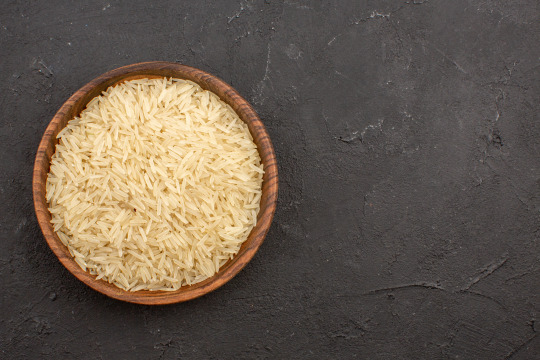
Introduction
Basmati rice, often referred to as the "king of rice," is a long-grain variety known for its distinctive aroma, nutty flavor, and fluffy texture. This rice is a staple in many households around the world, particularly in South Asian cuisine. In this blog, we will explore the origins, characteristics, nutritional benefits, cooking tips, and various uses of Basmati rice, providing you with everything you need to know about this beloved grain.
Origins and History
Basmati rice has a rich history that dates back thousands of years. The word "Basmati" comes from the Sanskrit word "vasmati," which means "fragrant" or "aromatic." This rice variety is primarily grown in the Indian subcontinent, with India and Pakistan being the largest producers and exporters. The unique climate and soil conditions of the Himalayan foothills contribute to the distinct characteristics of Basmati rice.
Characteristics of Basmati Rice
Basmati rice stands out from other rice varieties due to its unique features:
Aroma: The most notable characteristic of Basmati rice is its aromatic fragrance, which is often described as popcorn-like or pandan-like.
Grain Length: Basmati rice grains are long and slender, typically measuring 6.61 to 7.5 millimeters in length.
Texture: When cooked, Basmati rice becomes light, fluffy, and non-sticky, with each grain remaining separate.
Aging: Basmati rice is often aged for several months to enhance its flavor and aroma. Aged Basmati rice has a more pronounced fragrance and superior cooking qualities.
Nutritional Benefits
Basmati rice is not only delicious but also offers several nutritional benefits:
Low Glycemic Index: Basmati rice has a lower glycemic index compared to other rice varieties, making it a better option for those managing blood sugar levels.
Rich in Fiber: Whole grain Basmati rice, also known as brown Basmati rice, retains its bran layer, providing higher fiber content, which aids in digestion.
Vitamins and Minerals: Basmati rice contains essential vitamins and minerals such as thiamine, niacin, vitamin B6, iron, magnesium, and phosphorus.
Low in Fat: Basmati rice is naturally low in fat, making it a healthy addition to a balanced diet.
Cooking Tips
Cooking Basmati rice to perfection requires a few simple steps:
Rinse: Rinse the rice thoroughly under cold water to remove excess starch and prevent it from becoming sticky.
Soak: Soak the rice in water for 20-30 minutes before cooking to help the grains elongate and cook evenly.
Water Ratio: Use a 1:1.5 or 1:2 rice-to-water ratio for fluffy rice. For example, use 1.5 to 2 cups of water for every cup of rice.
Cook: Bring the water to a boil, add the rice, and then reduce the heat to low. Cover and simmer for 15-20 minutes until the water is absorbed.
Rest: Let the rice rest for 5-10 minutes after cooking, with the lid on, to allow the steam to finish cooking the rice.
Fluff: Fluff the rice gently with a fork before serving to separate the grains.
Culinary Uses
Basmati rice is incredibly versatile and can be used in a wide variety of dishes:
Biryani: A fragrant, spiced rice dish layered with marinated meat or vegetables.
Pulao: A simple, aromatic rice dish cooked with spices, vegetables, and sometimes meat.
Fried Rice: Basmati rice works well in fried rice recipes, providing a distinct flavor and texture.
Rice Salad: Cold Basmati rice can be mixed with vegetables, herbs, and a light dressing for a refreshing salad.
Plain Rice: Basmati rice is perfect as a side dish to curries, grilled meats, and vegetables.
Popular Basmati Rice Recipes
Here are a few popular recipes that showcase the versatility of Basmati rice:
Chicken Biryani: A classic Indian dish made with marinated chicken, fragrant spices, and layered with Basmati rice.
Vegetable Pulao: A simple yet flavorful dish made with mixed vegetables and aromatic Basmati rice.
Lemon Rice: A tangy and refreshing South Indian dish made with lemon juice, peanuts, and Basmati rice.
Kheer: A creamy and sweet Indian rice pudding made with Basmati rice, milk, sugar, and flavored with cardamom and saffron.
Conclusion
Basmati rice is a treasured ingredient in many cuisines around the world, celebrated for its unique aroma, flavor, and texture. Its versatility in cooking, along with its nutritional benefits, makes it a valuable addition to any kitchen. Whether you're making a rich and hearty biryani or a simple side dish, Basmati rice is sure to elevate your culinary creations. So, the next time you're planning a meal, consider incorporating this aromatic and delicious rice variety to delight your taste buds and nourish your body.
0 notes
Text
Nourish Your Health with Sugar-Free Rice from the Best Distributor in Hyderabad
Are you on the lookout for sugar-free rice that not only tastes great but also promotes better health? Look no further than FitCrop, the leading distributor of sugar-free rice in Hyderabad. Our premium-quality rice is meticulously sourced and processed to ensure maximum nutrition and flavor, making it the perfect choice for health-conscious individuals.

The Importance of Sugar-Free Rice
Why Choose Sugar-Free Rice?
Health Benefits: Sugar-free rice offers numerous health benefits, especially for those looking to manage their blood sugar levels or follow a low-carb diet. By eliminating added sugars, our rice helps prevent spikes in blood sugar levels, making it suitable for individuals with diabetes or those watching their sugar intake.
Weight Management: Unlike traditional rice, which is high in carbohydrates and calories, sugar-free rice provides a lighter alternative for weight-conscious individuals. It helps keep you feeling full for longer periods, reducing the urge to overeat and aiding in weight management.
Digestive Health: Our sugar-free rice is rich in fiber, which promotes digestive health by supporting regular bowel movements and preventing constipation. It also helps maintain a healthy gut microbiome, which is essential for overall well-being.
FitCrop: Your Trusted Sugar-Free Rice Distributor in Hyderabad
Why Choose Us?
Quality Assurance: At FitCrop, we prioritize quality above all else. Our sugar-free rice undergoes rigorous testing and quality control measures to ensure that it meets the highest standards of purity and freshness.
Variety: We offer a wide range of sugar-free rice varieties to suit every palate and dietary preference. Whether you prefer long-grain, short-grain, Basmati, or brown rice, we have something for everyone.
Convenience: Ordering from FitCrop is quick, easy, and convenient. Simply visit our website, browse our selection of sugar-free rice products, and place your order online. We offer doorstep delivery across Hyderabad for your convenience.
Transform Your Meals with Sugar-Free Rice
Delicious and Nutritious Recipes
Sugar-Free Rice Pulao: Try our delicious sugar-free rice pulao recipe, packed with aromatic spices, colorful vegetables, and protein-rich ingredients for a wholesome meal that's sure to satisfy your taste buds.
Sugar-Free Rice Khichdi: Indulge in the comforting flavors of our sugar-free rice khichdi, a nutritious one-pot meal made with lentils, vegetables, and fragrant spices, perfect for a cozy night in.
Experience the FitCrop Difference Today!
Don't compromise on taste or nutrition when it comes to your rice. Choose FitCrop as your trusted distributor of sugar-free rice in Hyderabad and experience the difference firsthand. With our premium-quality rice products, you can enjoy delicious, healthy meals without compromising on flavor or health benefits. Order now and embark on a journey to better health with FitCrop!
0 notes
Text
Ways to use ghee in cooking
Today there are many companies that sell Indian ghee in Australia.Ghee is usually lighter on the palate in comparison to butter, and has a defined nuttiness that comes from the caramelization of the milk solids. As ghee is clarified, it is both casein and lactose-free. People who are officially lactose intolerant can easily eat and digest it. After buying Desi ghee in Australia, you can use it in several ways. Ghee works well as an alternative to vegetable or canola oil, one that imparts a distinctive indescribable aroma and flavor. It can be a good idea to follow a 50:50 oil-to-ghee ratio for cooking various dishes. You may use ghee in your morning eggs and pancakes, lentils and pastas, roasted sheet pan veggies, and even to saute shrimp. An increasing number of people today use ghee interchangeably with butter for grilling, sautéing vegetables, as well as slow-cooking meat dishes like roast chicken. You may even make popcorn in ghee instead of butter. Popcorn made with ghee usually feels less greasy than the typical buttered popcorn.
Using ghee for cooking would be a great way to maximize the flavors of root vegetables in winter. You can even use ghee for cooking various one-pot rice dishes. Ghee can provide a great aroma and taste to a pilaf or an Indian pulao, or even certain Middle Eastern recipes.
Best ghee in Australia can also be used for baking cakes. There are many places in India where ghee is widely used for making cakes. For instance, in Goa, once a Portuguese colony, the much popular moist baath cake is made of coconut, semolina, and ghee. On the other hand, in the erstwhile French colony of Pondicherry, the Christmas cake is made of semolina, rum-soaked nuts and raisins, and ghee.
0 notes
Text
In a culture where food is more than simply subsistence but also a cultural identity, adding healthful components into traditional dishes is critical. Danodia Foods acknowledges the uniqueness of Indian cuisine, as well as the importance of making healthy choices. We proudly propose a blend of Western and Indian culinary techniques, featuring superior organic millets, to appeal to the Indian palate while encouraging health. Let's look at three delicious millet recipes that combine the best of both worlds.
1. Seasonal Vegetables with Masala Millet Pulao
Our Masala Millet Pulao with Seasonal Vegetables is a pleasantly gratifying dish that promotes your health journey without sacrificing taste. Start your weight reduction journey with it and enjoy the savory voyage. Created from organic millet from Danodia Foods, this pulao is loaded with fiber and vital nutrients, plus it tastes great! It's a great complement to any weight loss menu. Not only do spices like cumin, turmeric, and garam masala enhance flavor, but they also have the ability to speed up your metabolism, which can help you lose weight. Each bite of this pulao, paired with a vibrant array of seasonal veggies, is a step toward a healthier, more trim you. For individuals who want to reach their wellness objectives without compromising on taste or satisfaction, our Masala Millet Pulao with Seasonal Vegetables is the ideal option thanks to its healthy components and weight loss-friendly characteristics.
Ingredients: * 1 cup organic millet from Danodia Foods * 2 cups water * 1 tablespoon ghee (clarified butter) * 1 teaspoon cumin seeds (Jeera) * 1 finely chopped onion * 2 minced cloves of garlic * 1 finely chopped green chilli * 1 cup mixed seasonal vegetables (e.g., carrots, peas, bell peppers) * ½ teaspoon turmeric powder * Salt to taste * Fresh coriander leaves (Dhania)
Instructions: * Rinse millet with cold water and drain. * In a saucepan, heat the ghee over medium heat. Allow cumin seeds to splutter. ● ● ● ● ● ● ● ● ● ● ● ● ● * Add the chopped onions, garlic, and green chilies. Sauté onions until they are golden brown. * Cook mixed vegetables till slightly soft. * Add the rinsed millet to the pan, along with the turmeric powder, garam masala, salt. Mix thoroughly. * Pour water into the pan and heat to a boil. Reduce heat, cover, and simmer for 15-20 minutes to cook millet and absorb water. * Garnish with fresh coriander before serving hot.
2. Millet Upma with Coconut and Cashews You may start your day with our Millet Upma with Coconut and Cashews. This substantial breakfast option will support you in your weight loss efforts in addition to meeting your taste buds. Made with organic millet from Danodia Foods, this upma is packed of fiber, protein, and healthy fats to keep you feeling full and satisfied during the morning and prevent cravings. The coconut and cashews add a wonderful crunch, but they also provide energy and essential nutrients to fuel your day. Regardless of your health objectives, our Millet Upma with Coconut and Cashews is the perfect choice for a nutritious and delicious start to your day.
0 notes
Text
Plov is a rice pilaf-style dish that became popular in the Soviet Union by way of Uzbekistan. Plov’s popularity in Russia can be traced back to at least the time of Alexander the Great. Upon returning from Central Asia to Macedonia, his soldiers were said to have brought back plov as one of their new favorite foods. The existence of this dish in Central Asia has a distinct tie to the Jewish community there. The Bukharian Jews of Central Asia are Mizrahi Jews whose lineage goes back to the time of King David and ancient Persia. During the reign of Persia’s Cyrus the Great, Jews made their way to Central Asia and formed a community where they eventually spoke a dialect of Persian called Bukhori. Central Asian versions of plov, particularly the Uzbeki variety, were later popularized across all Soviet republics during the time of the Soviet Union.
Plov can be similar to Indian pulao or Spanish paella, though ultimately, there are countless cultures that have some version of a one-pot rice and meat dish.
Soviet-style plov is most commonly made with lamb as its meat, carrots as its vegetable, and is typically spiced with cumin and coriander. However, you will find a wide range of plov made with different kinds of meat or poultry, spices, and even the addition of dried fruits or nuts.
I prefer to keep plov simple with traditional flavors. I use chicken thighs for their availability and affordability, and add loads of carrots and onions, which seem to magically disappear into the rice once cooked. Garlic, bay, cumin and coriander perfume this plov. This dish is a one-pot meal. Once all of the ingredients are prepped, it comes together quickly and then gets popped into the oven to finish cooking. It reheats and freezes well, and is hearty and filling.
14 notes
·
View notes